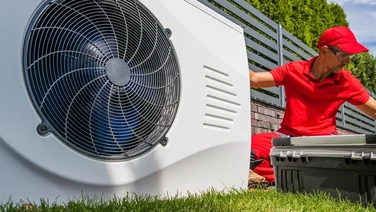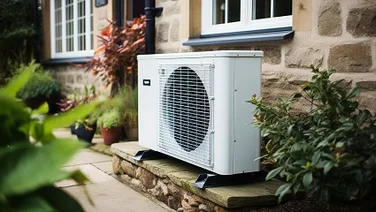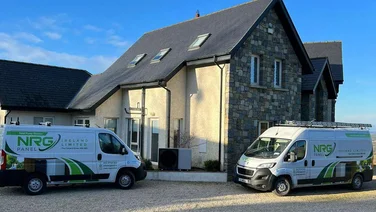✔ Geothermal energy is an unlimited energy source
✔ Ground source heat pumps use geothermal energy
✔ It has the potential to meet the entire world’s energy needs
Many of us are familiar with solar, wind, and hydro power, but people tend to be less familiar with geothermal energy, which is a renewable source used to power heat pumps and other green tech.
We’ve investigated geothermal energy here, looking at what it is, how we can use it, its advantages and disadvantages, and what impact it could have on the UK.
What type of central heating do you currently use?
Get started
What is geothermal energy?
Geothermal energy is a renewable power source generated by heat rising from the Earth’s core. This source was created during the formation of the planet, and is stored in rocks and fluids in the centre of the Earth.
Unlike a hot plate of food that cools when left alone, geothermal energy remains warm because of a constant process between the Earth’s surface and its core.
As long as Earth’s core continues to spin, geothermal energy will make its way to the surface and we can use this as a renewable energy source.
This concept isn’t new either — cultures around the world have relied on geothermal energy for thousands of years for cooking and heating. The ancient Romans used it to heat their public baths, for example.
Today, we use geothermal energy to power technology such as ground source heat pumps, which we can use to heat our homes without burning gas or other fossil fuels.
The other major use of geothermal energy is in generating electricity — steam from heated water rising from the earth can be used to turn turbines.
How do we capture geothermal energy?
We capture geothermal energy in different ways, depending on how we use it. For residential uses such as ground source heat pumps, we either dig deep boreholes or install pipes a metre or so underground.
The former is more challenging and requires drilling to a depth of around 60–200 metres — this is known as a vertical installation. It’s the most expensive method, costing £49,000 for a three-bedroom property, on average.
Installing pipes under the soil is called a horizontal installation, and is far simpler. This is because you only need to dig directly below the soil, rather than having to drill a borehole many metres below the surface.
It’s also cheaper than a vertical installation, typically setting you back £24,000 for a four-bedroom home.
The main disadvantage is that it requires a large surface area to generate enough heat.
Both types of ground source heat pumps are costly, but you can get a grant worth £7,500 with the government’s Boiler Upgrade Scheme.
The process power plants use to capture geothermal energy is very similar to a vertically installed domestic ground source heat pump.
Engineers will drill a borehole – though a much larger one than at your home – to capture the heat rising from the Earth’s core, which is used to generate steam from water. This powers a turbine that generates electricity.

The advantages of geothermal energy
Renewable
Geothermal energy is completely renewable and will last until the sun destroys the Earth in around five billion years’ time. As long as the world keeps spinning, the planet’s geothermal reservoirs will continue to replenish themselves.
This makes geothermal energy one of the most reliable forms of renewable power around — the main issue is building the infrastructure needed to extract it.
Environmentally friendly
It doesn’t have a completely perfect carbon footprint, but geothermal energy is much cleaner than fossil fuels. The only emissions involved come from minor natural gas leaks during the borehole drilling process.
Once a geothermal power plant is up and running, there’s effectively no emissions produced.
It’s incredibly green for homes, too. Ground source heat pumps require very little maintenance, and have the capacity to heat properties for over 80 years.
Massive potential
The world’s energy consumption sits at around 23,900 terawatts (TW) per year, which equates to 136 TW per day. Geothermal energy could be used to meet much of this demand.
We can’t yet extract enough geothermal energy, but the potential is huge. One study suggests geothermal energy could account for around 200 TWh per day globally by 2050.
That’s more than enough to meet current energy demands for every person on Earth and certainly enough to cover the UK’s energy needs. Total energy consumption in the UK was 1,651 TWh in 2019, so it would take just eight days for a daily supply of 200 TWh of geothermal energy to meet this demand.
More stable
Geothermal energy is constantly being produced, and is always available. Wind and solar energy on the other hand, are only available intermittently — the wind isn’t always blowing, and solar panels don’t work at night.
And using massive batteries to store solar energy isn’t the best solution, because the materials needed to build them can suffer shortages.
This makes geothermal energy a great choice for the future, as moving to a completely renewable world will need reliable energy sources.
Geothermal energy doesn’t fluctuate to anywhere near the same degree solar and wind power does. That allows us to accurately calculate the energy output, so we can better plan around consumption trends.
What type of central heating do you currently use?
Get startedThe disadvantages of geothermal energy
Location specific
Geothermal energy can’t be accessed everywhere, which creates a lot of logistical issues. It’s harder to use heat generated by geothermal energy if you’re far away from the source, for example.
This means not everyone can rely on geothermal energy, so it’s unlikely it’ll make up the bulk of future energy sources when we completely move away from fossil fuels.
Expensive to set up
Harnessing geothermal energy is an expensive process. The typical cost of building a small one-megawatt (MW) power plant is between £1.7 million and £6.1 million.
A 500 MW power plant would cost around £2.5 billion to build. This is much higher than the average cost of installing a gas power plant with an equivalent power output, which is roughy £400 million according to recent estimates.
However, geothermal power plants are long-term investments, and because geothermal energy is an unlimited source, they will in time become cheaper than fossil fuel plants.
Environmental issues
When we dig into the Earth to exploit geothermal energy, gases stored underground are released. This happens naturally, but the process of drilling for geothermal sources accelerates the process.
However, the amount of gas released pales in comparison with the number of pollutants pumped into the atmosphere when we burn fossil fuels. Any emissions from leaked gas will be offset by the geothermal energy we produce.
Geothermal power in the UK
A study from researchers at Durham University found there’s a lot of geothermal potential in the UK.
The researchers pointed out that Southampton already benefits from geothermal energy, extracting 1.7 MW of heat from the Wessex Basin to warm homes in the city.
These geothermal heat sources can be found across the UK, and it’s only a lack of infrastructure that’s stopping us from all using them.
It’s estimated that the UK’s accessible heat reserves are around 200 exajoules — that’s 34,800,000,000 barrels of oil equivalent, or around 100 years’ supply.
There are currently no concrete plans to expand the UK’s geothermal reserves, nor has the UK government announced any strategies focusing on geothermal energy.






